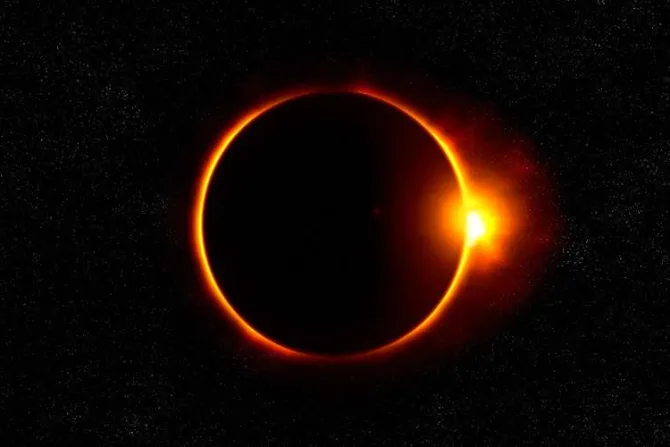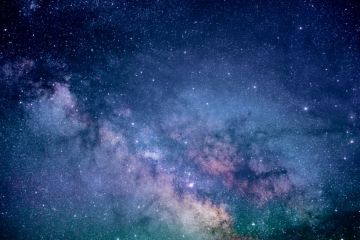National Catholic Register, Apr 7, 2024 / 14:00 pm
When the moon passes between the sun and Earth creating a total solar eclipse on April 8, many Catholics in its path will be looking skyward to observe the phenomenon from a spiritual and scientific perspective.
Some will gather at retreat centers like Our Lady of the Pines in Fremont, Ohio, to reflect on the eclipse as a metaphor for the darkness and shadow in their own lives, while others, like a group of students at the Catholic University of America who will be studying the eclipse in collaboration with NASA’s Goddard Space Flight Center, will take a more methodical approach.
A partial solar eclipse will be visible throughout North America and Central America on April 8, but only those in what is known as the “path of totality” will be able to observe the sun completely eclipsed by the moon.
In the United States, this includes parts of Texas, Oklahoma, Arkansas, Missouri, Illinois, Kentucky, Indiana, Ohio, Pennsylvania, New York, Vermont, New Hampshire, and Maine.
Vatican Observatory
At the Vatican Observatory, the total eclipse won’t be viewable at the two locations, through the main telescope on Mount Graham in Arizona or through the historic telescopes at Castel Gandolfo south of Rome, so staff members will be doing what everyone else is doing: going to the path of totality to see the eclipse.
Two of them — Jesuit Brother Guy Consolmagno, observatory director, and Christopher Graney, an astronomer and adjunct scholar — will be in Bloomington, Indiana, as presenters for a four-day “Faith and Science” retreat at Mother of the Redeemer Retreat Center. Besides Mass and morning and evening prayer, the retreat will include talks on such topics as “Astronomy and the Vatican” and “Where Faith and Science Can Meet,” along with opportunities for stargazing and, of course, viewing the eclipse.
Although some religious observers believe the coming eclipse has spiritual and even prophetic significance, Mark Mallett, a Canadian author and evangelist who views his role as one of watching, praying, and listening to what God is saying to the Church, said he is not aware of any Catholic sources pointing to the eclipse in that way.
However, he added: “This is not to say that this coming eclipse could not bear significance. Before the internet and modern astronomy, generations looked more intently at the universe for symbolism and meaning. The very birth of Jesus was marked by the ‘star’ over Bethlehem. And Our Lord himself said in Luke 21:25: ‘There will be signs in the sun, the moon and the stars ...’ What are these signs exactly? We cannot say for certain, which is why it is prudent to ‘watch and pray,’ as he commanded. It is the ‘pray’ part that tempers and roots us in the present moment so that we don’t get carried away.”
The Vatican Observatory’s Graney said people still look to the universe for symbolism and meaning, as they did in biblical times. “If you believe God created the universe,” he said, “then the study of the universe is the study of God’s work, and it will teach you something about God; just as if you study a painting by Leonardo da Vinci, you will learn something about da Vinci.”
He added: “There is always something interesting going on in the sky. Sometimes that thing is spectacular and interesting, and everyone knows about it, like the eclipse; sometimes it is subtle and interesting and only astronomy nerds know about it.”
Graney said the star of Bethlehem, for instance, was not the spectacular thing often imagined. “[The Gospel] says the star was subtle, something only noticed by ‘nerds’ like the Magi. Herod had to ask them when it appeared. ... If the star had been spectacular, everyone would have known when it appeared. Given that, are we going to sift every subtle thing in the sky for some great meaning? There are people who do that. It hasn’t been very productive for them. The Church has throughout its history condemned such stuff.”
Heidi Osborne, executive director of Our Lady of the Pines Retreat Center in Ohio, said the center’s purpose in planning a retreat during the eclipse was merely to allow people to experience the majesty and awe of the eclipse as something guided by God’s hand and to give them time to reflect on it.
“There’s nothing we have found that specifically ties an eclipse to spirituality,” Osborne told the National Catholic Register, CNA’s sister news partner. “However, if you think about it, there are a lot of metaphors between darkness and light.” She added that eclipses often signify beginnings or endings and are times to bring people together, reminding them of their interconnectedness with each other and with God.
For their part, students in Catholic University’s Physics and Applied Space Weather Research program will be immersed in the science of the eclipse as they deploy magnetometers to measure magnetic fields in six remote locations along the path of totality both during and after the phenomenon. Using their instruments, they also hope to see if any space weather effects are observable from the ground during the eclipse.
Gang Poh, a space weather professor and NASA researcher, said the work the students will do during the eclipse is part of a research project started last semester aimed at teaching about the experimental techniques scientists commonly use to measure and observe the effects of space weather in Earth’s atmosphere. The project also is part of a larger collaboration with NASA to study not only the eclipse but also space weather. Poh said the students hope to publish their results in a scientific journal and share them with colleagues at NASA.
(Story continues below)
Scientists can learn many things during a solar eclipse, he said, because of the opportunity it presents to study the sun’s atmosphere, called the solar corona. Normally, the brightness of the sun prevents such study until the moon blocks it during an eclipse. Although modern technology has allowed the development of instruments to artificially block the sun during observation, Poh said, these are limited, and so a natural phenomenon such as the solar eclipse remains the best method for studying the sun’s atmosphere.
Some have pointed out that the path of the April 8 total eclipse will intersect with that of another solar eclipse that occurred Aug. 21, 2017. After another such intersection took place between eclipses in the U.S. in 1806 and 1811, a series of earthquakes struck along a fault line in the area of the intersection following the second eclipse.
Poh said, to the best of his knowledge, there is no scientific significance for the latest expected intersection.
He told the Register: “Our Earth and the moon move in a predictable motion around our sun, following known laws of orbital motions. Hence, it is expected that there will be similar or intersecting paths of totality for different solar eclipse events.”
He said there also is no known correlation between solar eclipses and earthquakes.
“Scientists don’t believe that there is any causality between both phenomena because the processes that drive either phenomenon are very different,” he said. “Solar eclipses occur due to the relative motion between the Earth, the moon, and the sun. Earthquakes are known to occur due to the release of stress built up underneath the surface from the motion of the continental plates.”
Those interested in viewing the April 8 eclipse should, if possible, travel to the path of 100% totality, Graney said.
“I know people who, in the 2017 eclipse, said, ‘Well, where I am the eclipse will be 99%, so how much difference can the extra 1% make?’ It can make the same difference as that one number on a lottery ticket: the difference between having all the correct numbers on the ‘giant jackpot’ lottery ticket versus having all the correct numbers but one,” he said.
“The sun is so bright, and our eyes so adaptable, that if any bit of the sun is not covered, what you see will be, at most, a slight dimming of things,” Graney said. “Shadows will be unusual, and you can see the mostly covered sun with protective glasses. But if the sun is 100% covered — that’s where the glasses come off and the awesomeness kicks in. So don’t settle for anything but 100%, for all the numbers on the ticket, if you can.”
Eclipse viewers are being cautioned not to look directly at the sun without eclipse glasses or a handheld solar viewer. Even viewing the sun through a camera, binoculars, or telescope without a special solar filter can cause serious eye injury.
Graney said someone near his town has put up a billboard with a picture of a total eclipse on it and the words, “See the wonder of God.” Nonetheless, he said he expects some will be unmoved by the idea of such a phenomenon occurring. “I am sure there will be a few people who are right in the path of totality who will prefer to stay inside and watch TV or place sports bets on their phone.”
This article was first published on April 5, 2024, at the National Catholic Register, CNA’s sister news partner, and has been adapted for CNA.






